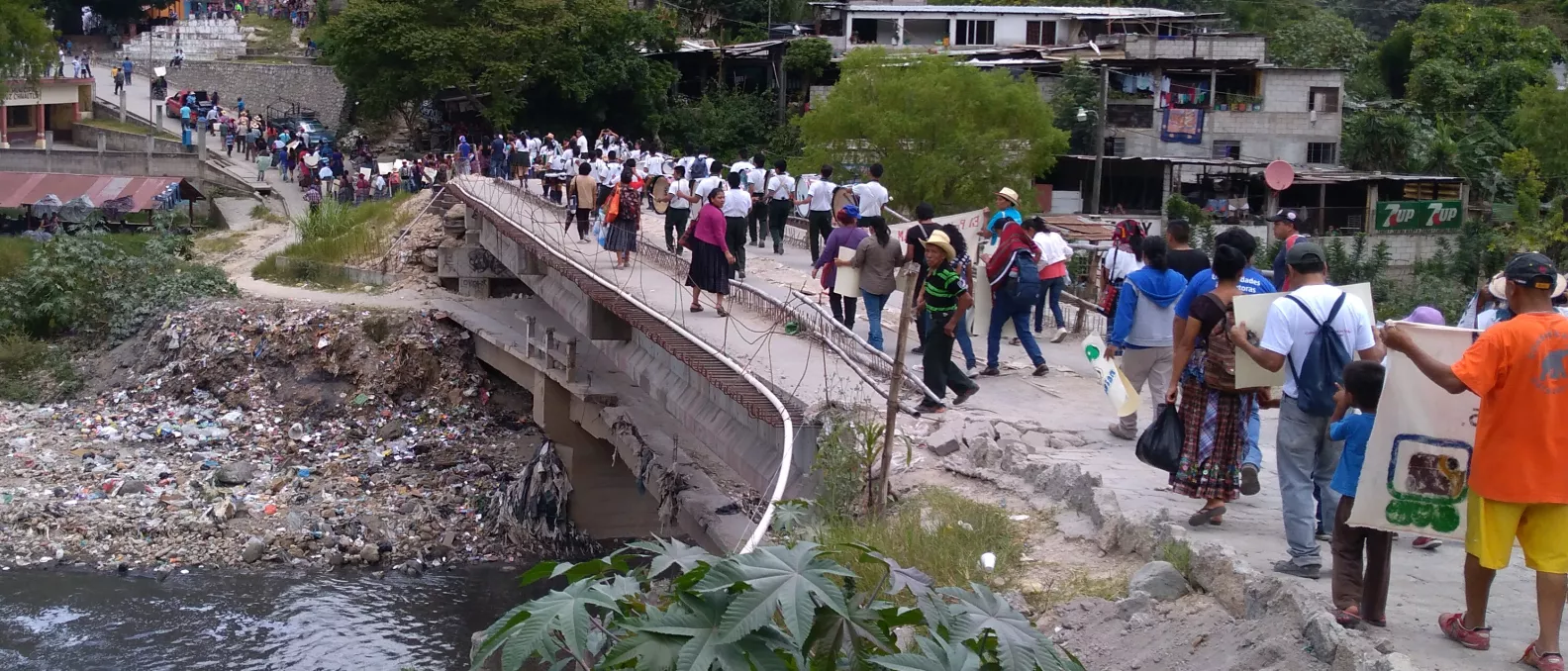
In December 2018 we began accompanying the Chinautla Multisector, which is composed of various actors from this area: communities from the municipality of Chinautla, the Community Development Councils (COCODE), Catholic and Evangelical Churches, youth groups and other collectives such as the Association of Women Potters and the Association of Women in Solidarity. It forms part of the Urban Platform, which is a movement of various groups, associations, multisector organisations and self-managed cooperative groups (housing among others), who have organized to defend various rights such as: the defense of territory, water, housing, food sovereignty and women’s rights.
Origins of the Resistance
The communities of Santa Cruz Chinautla face diversity of problems that threaten their life, territory and rights. One of these problems is environmental pollution, which is particularly severe during the rainy season, as a result of the increased flow and strength of two rivers, Las Vacas and Chinautla, which in turn increases the accumulation of solid waste. The waste originates from Guatemala City, where, for more than 75 years, the city’s sewage has been diverted into a river that originates in Zone 3 of the City. Waste water rivers from the Municipalities of Mixco, San Juan Sacatepéquez and of Chinautla itself all flow together through Chinautla. There is not only waste water, but also solid waste carried down by the rivers which turns the riverbed in Chinautla into a landfill.1 In addition, the large-scale clay extraction projects have added to the problem of pollution, resulting in diversions to the course of rivers, alterations to river banks, the weakening of local infrastructure, cracks in homes and an increase in respiratory diseases.
The bridge that enters the village of Santa Cruz Chinautla has flooded and collapsed several times. The population of Chinautla has denounced this situation for years.2 It is estimated that some 1,550 families live within the area of risk.3 Given this situation, and in the face of a further collapse of the bridge in June 2018, the population decided to organize a peaceful resistance for two weeks at km 11 on the road to Chuarrancho and San Antonio Las Flores. The objective of this resistance was to denounce the damage caused to the local infrastructure by the clay extraction companies, as well as the serious problems caused by the waste carried by the Chinautla River (from the landfill in Zone 3). The population’s principal demand is from the clay companies to cease operations.
One of the clay extraction companies reacted to this peaceful protest by accusing Efraín Martínez and Francisco Vásquez, members of the COCODE for Santa Cruz Chinautla and the Multisectoral, of threats and illegal detentions4.
Challenges Facing the Population
The municipality of Santa Cruz Chinautla neighbors Zone 6 in the north of Guatemala City. It was built “on an old landslide located in a geologically unstable area due to the existence of several faults.”5 The 1976 earthquake caused more cracks to open, forcing the Santa Cruz Chinautla municipality to relocate to upper Jocotales, forming the New Chinautla settlement. “The so-called Old Town is located in a rugged valley cut through by the Chinautla River, and prone to disasters due to floods and partly due to the waste washed down from the capital city. The valley in question ends where the Chinautla River and Tzaljá rivers flow into the Las Vacas River” where most of the clay companies are located6.
In 2011, Chinautla was home to 118,510 inhabitants and a population density of 1,481 per square kilometer,7 which makes it one of the most populated municipalities in the country. The population of Santa Cruz Chinautla is of Maya Poqoman origin. Their main activities are the pottery and clay crafts that are sold in markets throughout the country. The artisans who dedicate themselves to this activity are being strongly affected by the large-scale extraction of clay carried out by the companies, as this is the raw material they use for their work and it is becoming increasingly scarce.
In May 2018, one month before the Resistance was formed, the Department of Monitoring and Risk Management of the National Coordinator for Disaster Reduction (CONRED), gave an updated analysis on the situation in Santa Cruz Chinautla. This report stated that, both the situation of environmental pollution and extractive activities, are impacting the environment and the public health of the population and hinder the construction of housing in various parts of the municipality, because there is no urban planning in line with the topography of the area8.
A simple walk through the community evidences the ecocide that is taking place. The river is literally a river of garbage, the banks are not even visible due to the enormous amount of waste. The whole river is covered with white foam and the smell is unbearable. The garbage reaches some side streets in the village.
Clay extraction and the arrival of big business
Clay extraction in this area has been present for decades, nevertheless the nature of this activity has transformed over time. 50 years ago, clay was extracted on a small scale and in small quantities, as it was principally used in community’s artisan production. However, when Aroldo Medrano9 became mayor, he began the process of industrial extraction using machinery and trucks from the capital. These licenses for the large-scale extraction of clay were granted by Medrano, and without consulting the affected communities. The right to free, prior and informed consultation is one of the demands of the Chinautla Multisector , since the Maya Poqoman population forms part of this organisation.
“Since the 1980s, when Mr. Medrano was mayor, we have observed the proliferation of companies that exploit quarries, from which they have been extracting clay and other material. Some of them are owned by the mayor, according to the neighbors, however they are not registered under his name. One such company is Arenera K-9, which has continued to destroy the hills that once protected the community. This extractive activity and the boom in the construction industry has gained much momentum recently, which has increased the exploitation of clay extraction from the Chinautla and Las Vacas rivers, as well as the manufacture of gravel and the extraction of earth, white sand and other materials, both within the surroundings of Santa Cruz Chinautla” as in other nearby communities10.
At present there are multiple mines operating in the territory, of which only some have valid licenses. The community most affected by extractive activities is Santa Cruz Chinautla. The closest houses to the clay beds are 500 meters away. There used to be more than 150 families living there, but now only 20 remain, the others have been moved and relocated elsewhere11.
Attempts at Dialogue
The Chinautla Multisector asked the Human Rights Ombudsman (PDH) to intervene by establishing a process of contact and mediation between the parties. On July 3, 2018 a roundtable for dialogue was created with members of the Chinautla Multisector, the Ministry of Energy and Mines (MEM) and of Environment and Natural Resources (MARN), the Executive Secretary of CONRED (SE-CONRED) and the representatives of the clay extraction companies. The Municipalities of Guatemala and Chinautla were also called to participate, as well as the Governors office, but they did not attend.
The commitments established were:
Preparation of reports on the environmental impact of the clay extraction companies in question, by the MARN and the MEM.
Preparation of environmental management plans by the companies.
Preparation of a risk management plan by SE-CONRED.
Tour of the area, with all institutions, to verify the damages of extractive activities.
So far, neither the government authorities nor the private companies have complied with the agreement. The clay extraction companies argue, repeatedly, that they do not extract clay but that they collect the clay that the river drags. They also argue that the activities are carried out below Santa Cruz Chinautla’s urban center, therefore, there should be no discernible geological link with the damage to the houses and hillsides that affect the population12. However, as described throughout this article, the Chinautla Multisector and other sources aware of the situation, highlight the serious damage that large-scale clay extractive activity is causing in the area.
1Community Development Association SERJUS, Problemática del Pueblo Poqomam en Santa Cruz Chinautla, June 2018.
2NISGUA, Residents of Santa Cruz Chinautla denounce eco-ethnocide, 1.09.2011
3Q., O. F., Entre paredes rajadas: así viven mil 550 familias por hundimiento de la vieja Chinautla, Prensa Libre, 18.05.2018
4Source: Chinautla Multisector
5Del Aguila, A., El negocio de las areneras y su afectación a la población urbana: el caso específico del municipio de Santa Cruz Chinautla, Enfoque No. 63, 20.12.2018
6Ibid.
7Ibid.
8Ibid.
9Arnoldo Medrano was elected mayor in 1986 and re-elected six consecutive times. In 2015 he was arrested and is being prosecuted in different legal cases and for various crimes, such as embezzlement, falsification of documents, use of forged documents, fraud, illicit association and money laundering. According to investigations by the Public Prosecutor’s Office (MP) and the International Commission against Impunity in Guatemala (CICIG), he established “a family network of corruption” to loot the municipality of Chinautla during the 30 years of his administration (information extracted from several articles of Prensa Libre and elPeriódico between 2015 and 2017).
10Community Development Association SERJUS, Op. Cit.
11Source of Information: Chinautla Multisector
12Del Aguila, A., Op.Cit.
